Holiday Budget System Buyers' Guide
by Zach Throckmorton on November 8, 2011 12:00 AM ESTMotherboards and Features
As mentioned earlier, Cougar Point chipset-based motherboards are fully diversified into every cost niche of the motherboard market. While cutting-edge, flagship motherboards garner the most attention from enthusiasts, inexpensive, no-frills boards are generally just assumed to all be more or less equivalent in performance. But does performance vary between these budget boards? We briefly benchmark a few important motherboard features: LAN, SATA, and USB 2.0 throughput. But before we get to the benchmarks, let's compare features.
I tested eight different budget motherboards—four socket AM3 with AMD chipsets, one FM1 with the A55 chipset, and three based on Intel chipsets (all LGA 1155). Here's a quick rundown of the various features for each board.
| Product |
Platform/ Chipset |
Price |
RAM slots |
Rear USB ports |
LAN |
Graphics ports |
SATA ports |
Expansion slots |
| ASRock A55M-HVS |
FM1 / A55 |
$59 | 2 | 6 USB 2.0 | 1Gb | VGA, HDMI | 6 |
1xPCIe x16 1xPCIe x1 1xPCI |
| ASRock 880GM-LE |
AM3 / 880G + SB710 |
$55 | 2 | 6 USB 2.0 | 1Gb | VGA, DVI | 6 |
1xPCIe x16 1xPCIe x1 2xPCI |
| Biostar A780L3L |
AM3 / 760G + SB710 |
$50 | 2 | 4 USB 2.0 | 100Mb | VGA, DVI | 4 |
1xPCIe x16 2xPCI |
| Biostar A870U3 |
AM3 / 870 + SB850 |
$70 | 4 |
2 USB 2.0, 2 USB 3.0 |
1Gb | VGA, DVI | 6 (6Gb) |
1xPCIe x16 1xPCIe x4 2xPCIe x1 2xPCI |
| MSI 760GM-P33 |
AM3 / 760G + SB710 |
$55 | 2 | 4 USB 2.0 | 1Gb | VGA | 6 |
1xPCIe x16 2xPCIe x1 1xPCI |
| ASRock H61M-VS |
LGA1156 / H61 |
$54 | 2 | 6 USB 2.0 | 100Mb | VGA | 4 |
1xPCIe x16 1xPCIe x1 |
| Biostar H61ML |
LGA1156 / H61 |
$60 | 2 | 4 USB 2.0 | 100Mb | VGA, DVI | 4 |
1xPCIe x16 1xPCIe x1 2xPCI |
| MSI H61M-P21 |
LGA1156 / H61 |
$55 | 2 | 4 USB 2.0 | 100Mb | VGA | 4 |
1xPCIe x16 3xPCIe x1 |
One thing to note is that of the above motherboards, Biostar and MSI offer 3-year warranties while ASRock offers a 1-year warranty. As you can see, in general, you'll get more for your money from an AMD-based motherboard than an Intel-based motherboard. That is, none of the Intel boards offer Gigabit ethernet, and only one offers DVI in addition to VGA connectivity; the FM1 board is also the only board with an HDMI port. Do the Intel platforms instead offer better performance? Let's find out.
Benchmarks
While we did not perform thorough testing like when we review a specific motherboard, we tested three important metrics for all eight boards: USB 2.0 performance, SATA throughput, and LAN performance.
USB 2.0 performance
We used a Mushkin Ventura Pro USB 3.0 flash drive and CrystalDiskMark 3 to test the sequential write and read speeds of a 1000MB file. While the Intel boards tend to perform better than the AMD boards, the differences here are very minor and would likely not be noticeable in real world scenarios. The single USB 3.0 equipped board would of course be able to run quite a bit faster with an appropriate USB 3.0 flash drive.
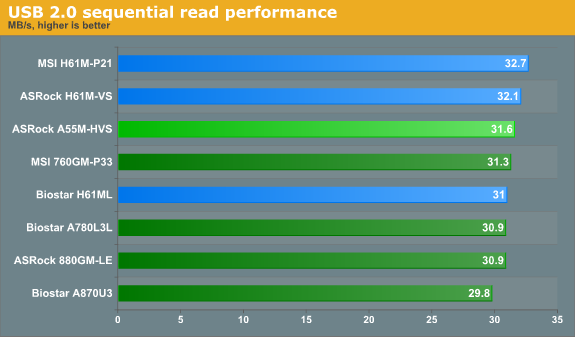
SATA performance
To test SATA performance, we again used CrystalDiskMark 3 to measure the sequential write and read speeds of a 1000MB file—with a Patriot Pyro 120GB SSD. This SSD is one of today's top performers and costs nearly $200—well above the budget sector. However, prices on SSDs will only fall as time passes, and this SSD illustrates what these boards are capable of better than a mechanical HDD. From these results, it's clear that all of the boards perform very similarly in terms of SATA throughput.
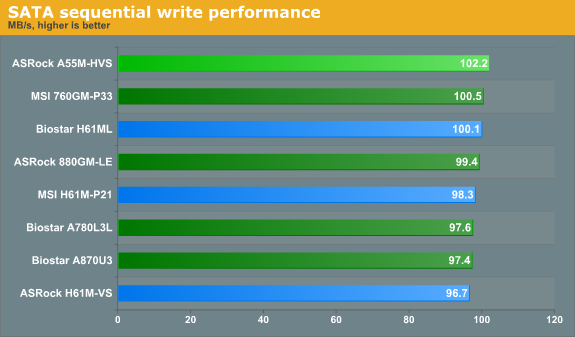

LAN performance
LAN Speed Test is a freeware program designed for testing the network connection between two PCs on a home network. The speed of the transfer is limited by the lowest common denominator on the network, so if you have gigabit ethernet capable computers but a 100 Mbit capable router, you are limited to 100 Mbit transfer. For this test, we use LAN Speed Test to transfer a 1000 MB file across a home network with a 100 Mbps lowest common speed to the same machine each time, in a write/read scenario. It is critically important to note that if you plan on attaching any of the Intel Cougar Point chipset-based boards in this guide to a network, you will be limited to 100 Mbps transfers as none of them have Gigabit adapters.
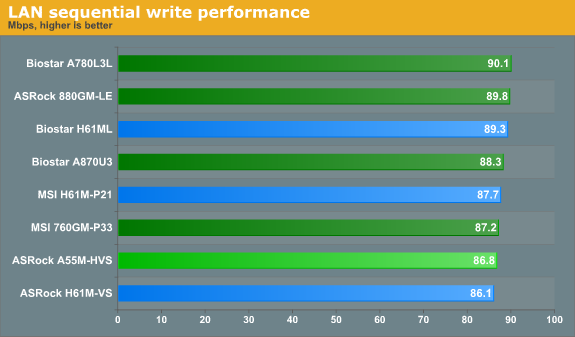
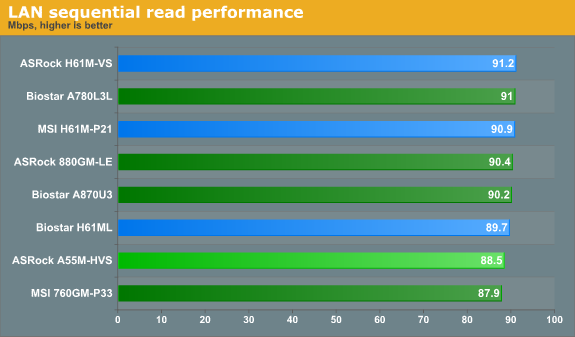
From these benchmarks, it appears that the budget boards are mostly equivalent performers. I was heartened to experience neither anomalous behaviors nor frustrating issues with any of the boards in the course of testing. Though it's somewhat disappointing to not find a hidden gem, it is useful to know that many budget boards are solid performers—so savvy consumers can watch for sales and rebates.
We cover the rest of the system components on the next page.


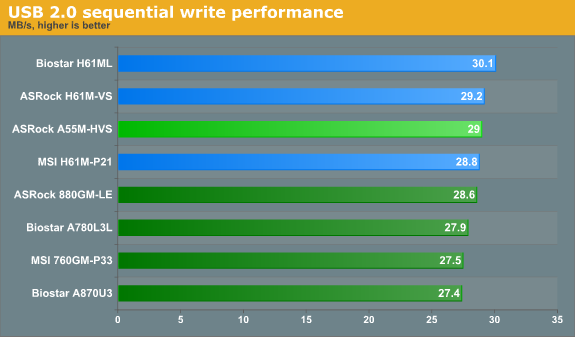








95 Comments
View All Comments
buildingblock - Tuesday, November 8, 2011 - link
I don't see how the X4 2.6Ghz 631 can ever even begin to be a winner against the Intel opposition. It is no more than an A6 3650 with the graphics unit disabled. My local hardware dealer is listing it at around 10% more than the Intel 2.8Ghz G840, which easily out-performs it and has a GPU. The budget end of the market is dominated by cheap Intel H61 motherboards and the 1155 socket Pentium G series, and the X4 631 brings nothing whatsoever to the table that's going to change that.Taft12 - Wednesday, November 9, 2011 - link
What analysis do you need to see? It is an A6-3650 with the graphics lopped off. If you want to know how it would do in CPU benchmarks, just look at a A6-3650 review.Despite the GPU sacrifice, you get no TDP savings. It's a piece of shit through and through not worthy of discussion.
mhahnheuser - Friday, November 11, 2011 - link
...you are spot on. But I can tell you why. Because if he ran the right discrete card in the Llano it would crossfire with it and then there would be absolutely no point to the comparison.mhahnheuser - Friday, November 11, 2011 - link
...so the conclusion should have been....don't buy the Celeron over Llano unless you add a fast discrete DX compatible gpu. He only tested the X2 so that he could validate the comparision to Llano by building a higher performing, higher cost Celeron system. The X2 is a old Gen processor whereas the Celeron tested is in Intel's SB family...how is that a basis for fair comparison?mhahnheuser - Friday, November 11, 2011 - link
Good observation. I second your opinion.Wierdo - Tuesday, November 8, 2011 - link
Maybe I'm missing something, but how come the performance difference between the X2 3.0Ghz and A4 2.5Ghz is so big?They're pretty much the same core give or take a few tweaks and an added GPU block, right? I don't understand how a 500mhz drop can lead to 30->19 sec in PPT to PDT conversion for example.
What am I overlooking here?
slayernine - Tuesday, November 8, 2011 - link
The A4 is a different processor, it is not from the same line as the X2 and thus performs quite differently. Also 500mhz can make a huge difference in single threaded applications. For example if you tried to play back a 1080p video without GPU acceleration (relying entirely on the CPU) the A4 would stutter at 2.5GHz but the X2 should be ok at 3GHz. However in reality the A4 is a much more well rounded processor that allows light graphical capabilities for gaming and video performance.Also some might point out that a significant portion of the A4 chip is dedicated to Radeon cores thus limiting the ability of the CPU portion through purpose build design.
Taft12 - Tuesday, November 8, 2011 - link
Wow, this is really coming out of your ass.The CPU part of Llano *IS* derived from good ol' K10 - Llano is/was referred to as K10.5
It DOESN'T perform "quite differently", Anand found in the A8-3850 review that its performance was quite close to the Athlon II X4:
<i>Although AMD has tweaked the A8's cores, the 2.9GHz 3850 performs a lot like a 3.1GHz Athlon II X4. You are getting more performance at a lower clock frequency, but not a lot more.</i>
slayernine - Tuesday, November 8, 2011 - link
It offers different features thus is quite different type of processor. One of those differences is the amount of CPU die dedicated to actual CPU functionality. I didn't say the CPU is portion is built differently. I am fully aware it is based on the same architecture. Perhaps I confused you in my choice of words.FYI Taft12 we are talking about the X2 3.0Ghz VS A4 not Athlon II X4 vs A8. The reason this matters is that the X2 3.0Ghz offers better CPU performance A4.
Summary: Clock for clock the X2 isn't much different from the A4 but the A4 is a lower clock speed and thus slower at CPU intensive tasks because half the the damn thing is a GPU! APU's at the same price point will generally be slower than the competing CPU. So perhaps the simple answer to Wierdo's question is simply: "Clock speed matters."
Wierdo - Tuesday, November 8, 2011 - link
Hmm...I don't see how 500mhz difference causes super-linear scaling in performance, 2.5/3ghz is less than a %20 difference, it shouldn't be more than %20 performance difference one would think - with the cores being from the same family (K10) for both products I'm missing where the balance can affect non-multimedia workloads.It's quite interesting from an academic perspective, If it was primarily limited to graphics type workloads I could understand, but I don't see it for stuff like PPT->PDF conversions for example.